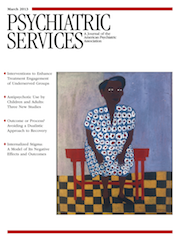Antipsychotic Use by Medicaid-Insured Youths: Impact of Eligibility and Psychiatric Diagnosis Across a Decade
Abstract
Objective
This cross-sectional study evaluated the impact of Medicaid-eligibility category on the increased use of antipsychotic medication by Medicaid-insured youths across a decade.
Methods
The authors analyzed computerized administrative claims data for 456,315 youths aged two to 17 years who were continuously enrolled in Medicaid in a mid-Atlantic state in 1997 (N=159,171) and 2006 (N=297,144). Bivariate and multivariable analyses quantified changes in antipsychotic use in relation to the youths’ psychiatric diagnosis and eligibility category (Temporary Assistance for Needy Families [TANF], state Children’s Health Insurance Program [SCHIP], Supplemental Security Income [SSI], and foster care). A second multivariable regression model examined changes in demographic and clinical characteristics of antipsychotic users with a psychiatric diagnosis.
Results
The prevalence of antipsychotic use increased from 1.2% in 1997 to 3.2% in 2006. The increase in odds of antipsychotic use in 2006 was greatest among youths enrolled in SCHIP (adjusted odds ratio [AOR]=5.9), followed by youths enrolled in foster care (AOR=4.1), TANF (AOR=3.6), and SSI (AOR=2.8). Among users of antipsychotics who had a psychiatric diagnosis, youths with externalizing behavior disorders and bipolar disorder had 2.4- to 3.8-fold greater odds of using antipsychotics in 2006 versus 1997 compared with youths with schizophrenia or other psychoses and pervasive developmental disorders. The proportion of youths using antipsychotics between 1997 and 2006 increased significantly more among African Americans and Hispanics than among whites.
Conclusions
The expansion of antipsychotic use was most prominent among youths who were Medicaid eligible because of low family income (SCHIP) and reflects increased medication use for behavioral problems.



